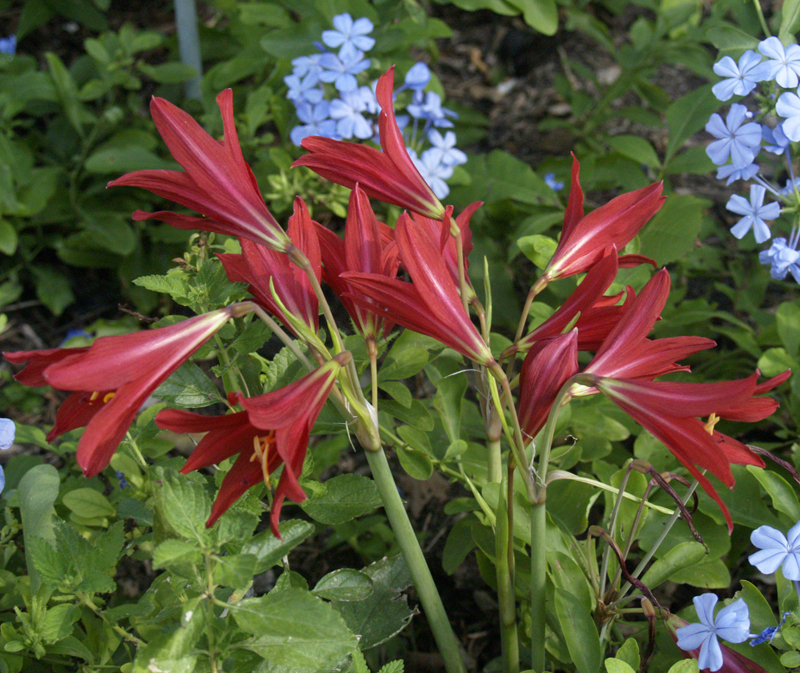October 20, 2011
What do you know? Flowers!! + Remarkable Trees w/Matt Turner
My, oh, my.

Three days after the rain, I came home to a surprise: flowers! I almost fell over. Though my oxbloods, tucked into plumbago, have yet to fail me.
A week ago, the Salvia greggiis looked on their death bed. “Not so fast with that shovel, sister.”

Each day brings another renewal, like these rain lilies, Zephyranthes candida.

I only planted my Lemon yellow rosemallow (Hibiscus calyphyllus) in late spring. I have given it extra water attention, but not a lot. The flowers are diminutive after its summer labors to stay alive, but if it handles winter, I’ll be getting more!

And yahoo! Guess who’s coming to dinner. . .for the next several months! I hope that these are straggler daisy (horseherb) seeds, but I know the others are winter weeds.

That strip of lawn between our carport and the neighbor’s house gets NO extra water. Last year, the horseherb made a beautiful lawn to replace the grass that went belly up. But it also gets the hot afternoon blast, and with no irrigation, even they went dormant this year.
Weeds and seeds are coming up everywhere. For gardeners, “weeds” are the ones we don’t want; “seeds” are the ones we do! It’s all in the eyes of the beholder.
This year, we behold lots of dying trees. On CTG, Tom meets with Matt Turner, author of Remarkable Plants of Texas, for a look at some remarkable trees.

Matt is the ultimate story-spinner with true tales of historical use, including why huisache made its way into French perfume, and how soapberry tree got its name as gentle laundry soap. One native of note is Texas persimmon (Diospyros texana), treasured for its lovely form and bark in garden design.

Its February flowers are fragrant enough to attract our attention, along with early bees. The Gray Hairstreak butterfly lays her eggs on the leaves to feed her hatching caterpillars. Later, wildlife dines on its fruits, as do we, but generally our palette enjoys them best when fully ripened.
Black walnut (Juglans nigra) is a large tree (50-75’) that does like moister soil.

It’s one of our finest carpentry hardwoods, so treasured that historically its native population has been exhausted for furniture and gunstocks.
This native tree is the larval plant favored by the Luna moth, Walnut moth and Walnut sphinx moth. Its nuts, high in omega-3, are considered the best tasting native nut second to pecans. Its leaves and hulls make a beautiful warm brown dye.

Get Matt’s CTG plant list here. And find out more about the rich history and secret stories of native plants in his book.

On tour, visit remarkable Peckerwood Garden and its founder, John Fairey.
They’ve weathered the drought well, and invite you to come take a look at their Open Days tours this fall. Wandering through its various microclimates will excite you with all-weather designs tested for everything that weather throws our way!
Some plants didn’t make it through drought, but I bet your Heart-leaf/heartleaf skullcap (Scutellaria ovata) did. This week, Daphne answers a great question from Chris Busse: hers went underground in the heat. Will they be back?

Yes, they will! Daphne notes: “Heartleaf skullcap is one of the relatively few plants that go dormant in summer, instead of winter, thus defying our ingrained view of how plants behave in response to seasonal changes. We’re quite accustomed to plants going dormant in the winter, but usually around here, if something dies back in the SUMMER, it actually IS dead.” But this plant likes cold weather!

It hunkers down in heat (like most of us) to return when cooler days arrive. Like Chris, I got scared the first year I had them, but they’ve returned reliably every year (and she reports that she’s spotted hers!).

They spread from underground roots, so when mine pop back up, I plan to divide them to put under perennials that will go dormant in a few months.
Last weekend, I planted a new one and a tiny native Plumbago scandens in the bed that recently got “aerated” for a new sewer pipe.

The plumbago is the one with the white flower in back. It will freeze back, but by next summer will fill that muted sun spot. This winter, the heartleaf will cover the ground. When it goes dormant next June or so, the plumbago will be in full gear. (The little plant on the left is a Gulf penstemon I dug up for the sewer line fix and just replanted).
Daphne’s pick of the week is Bamboo muhly (Muhlenbergia dumosa). This feathery grass is a drought-tough choice for those areas of muted sun, like under Pam Penick’s trees.

Mine has done beautifully in the front bed that gets dappled shade and blasts of afternoon sun.

I got a scare when it browned in the extreme freeze of 2009/early 2010, but it was a youngster.

Come spring, it was back! I cut the canes to the ground and off it went!

The 2011 freeze barely daunted it. For me, that’s part of the fascination of gardening: traveling from year to year to see what works and what happens.
And it’s certainly given me a gift that usually eludes me: patience. No matter what the tags or books or even CTG says, where do they work in our own soil and light, freeze, drought and flood? I’ve learned that even a few feet can make a difference on what happens. We’re scientists, all, in our own gardens.
Scientists and gardeners alike can tell you that our soil took a real beating this summer. On Backyard Basics, Merrideth Jiles fromThe Great Outdoors, explains how to rejuvenate it to pump up those microorganisms and in turn, your plants.

Until next week, Linda
tags:

